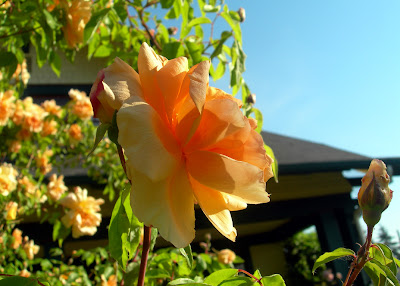 Tutorial: 'Remembering Mimi' Floral Locket Pendant Brooch
Tutorial: 'Remembering Mimi' Floral Locket Pendant Brooch My maternal grandmother died at age 51 when I was in the third grade; I still miss her 40+ years later. Her name was Ethel, but when I first tried to say 'Grandma' it came out 'Mimi'... and Mimi she was, to friends and family alike, for the rest of her days. This photo of her, in her back yard rose garden, is a favorite of mine and the inspiration for this project, which is going to be gifted to my mom on Mother's Day. I hope this may inspire you to create something in your own style that is meaningful to you.
This project is probably considered Intermediate in terms of difficulty.
Tools:
- Joyce Chen Ultimate Scissors (the best for cutting filigree and thin metal sheet)
- jeweler's files or grinding wheel for Flex Shaft
- steel twist drill bits: 3/32" and 1.6mm (3/32" step bit if using with quick-change flex shaft hand piece)
- polishing cloth or flex shaft
- basic jewelery-making pliers
- toothpics (for applying glue)
- assorted tweezers, needle tool, etc.
- spring clamps (always handy) or clothes pins
Materials:
- Brass hat stamping
- vintage locket, 1-1/2" (38mm) in diameter
- 3/32" diameter plated brass eyelet rivets
- 1/16" diameter eyelet rivets, assorted lengths
- brass filigree, approx. 40mm in diameter
- gold plated pin back with soldered bail, 1-1/4" (32mm)
- brass center leaf (I used this one, but many leaf stampings approx. 30mm long will work well)
- brass flowers
- brass pearl cup (or bead cap)
- brass accent leaves (I used a vintage piece, but this one - cut apart - would work well.)
- E6000 (I prefer these mini tubes)
- G S Hypo Cement (it's a pain, but it doesn't destroy the foil on the back of the rhinestones)
- Rhinestones
- Green Sharpie permanent marker
- Spray sealer (Krylon lacquer, etc.) and/or Renaissance Wax
 |
| Figure 1 |
This locket has a swedge hole, but it will be hidden under the hat. Seal the locket in and out.
 |
| Figure 2 |
Rivet the hat to the locket. Note: Riveting is important; lockets get opened and closed and glue may fail under the stress of repeated tugging.
 |
| Figure 3 |
Figure 3. Cut apart your leaf sprays and smooth the cut ends. Buff well; I used a brass brush on my flex shaft.
I used a green Sharpie permanent marker to color the ribbon trim on the hat, as well as the accent leaves; a red Sharpie colored the molded flowers. Let dry, then seal.
 |
| Figure 4 |
Figure 4. After coloring and sealing, I bent the leaf accents around the crown of the hat, securing with E6000 and spring clamps. Allow glue to dry, police up any stray glue and seal the entire hat.
I like the way it looked at this stage, and may do another and leave it more like this.
 |
| Figure 5 |
A touch of red Sharpie on some of the petal tips added a bit more color.
Clean up any stray glue, then allow it to cure for 24 hours. Once the glue has cured, give the hat and locket a final cleaning, buffing (if necessary) and another coat of sealer, if you used raw brass.
Set the rhinestones into the center of the flowers using G S Hypo Cement. If your stones are unfoiled, or if you are using beads or pearls, you can use E6000.
 |
| Figure 6 |
 |
| Figure 7 |
Tip: Open the pin so it's out of the way. Align the finding and hold in place with a spring clamp. Drill hole in filigree through the hole in the pin finding. Rivet and repeat.
 |
| Figure 8 |
 |
| Figure 9 |
Set the rhinestones and the central pearl, then attach the two parts using jump rings.
These are the photos that are going inside. Mom's going to love it. :-)
 |
| Mimi in her garden and with newborn baby Robin (me). |
 |
| Robin (me) at 50 |
She was also very artistic; she had a porcelain studio in her basement and created wondrous things from clay slip and molds as well as beautifully painted Made in Occupied Japan china. I treasure the few things from her hand that have survived to this day.
The anniversary of her passing approaches and she is very much on my mind. She is always in my heart.
I love you, Mimi.
Ta,
~R.




























































